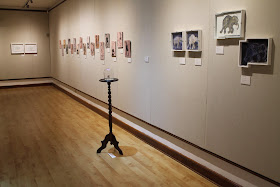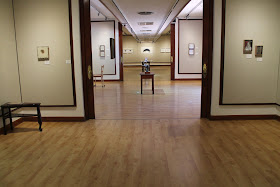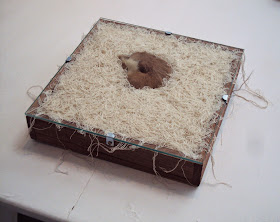“Out with you upon the wild waves, Children of the King!
Henceforth your cries shall be with the flocks of birds".
 |
Ann-Marie Tully, The children of Lir: Fionnula (what hands
have wrought) IV. Monotype and marbling on paper. 297mm
x 210mm.
|
%2BI_small.jpg) |
Ann-Marie Tully, The children of Lir: Fionnula (what hands
have wrought) I. Monotype and marbling on paper. 297mm
x 210mm.
|
%2BIII_small.jpg) |
Ann-Marie Tully, The children of Lir: Fionnula (what hands
have wrought) III. Monotype and marbling on paper. 297mm
x 210mm.
|
 |
Ann-Marie Tully, The children of Lir: Fionnula (what hands
have wrought) II. Monotype and marbling on paper. 297mm
x 210mm.
|
 |
Ann-Marie Tully, The children of Lir: Flidais's dance IV.
Monotype and marbling on paper. 297mm x 210mm.
|
 |
Ann-Marie Tully, The children of Lir: Flidais's dance II.
Monotype and marbling on paper. 297mm x 210mm.
|
 |
Ann-Marie Tully, The children of Lir: Flidais's dance III.
Monotype and marbling on paper. 297mm x 210mm.
|
 |
Ann-Marie Tully, The children of Lir: Flidais's dance I.
Monotype and marbling on paper. 297mm x 210mm.
|
_small.jpg) |
Ann-Marie Tully, The children of Lir: Sadhbh (mother of Oisin) I.
Monotype and marbling on paper. 400mm x 210mm.
|
 |
Ann-Marie Tully, The children of Lir: Sadhbh (mother of Oisin) III.
Monotype and marbling on paper. 400mm x 210mm.
|
 |
Ann-Marie Tully, The children of Lir: Sadhbh (mother of Oisin) II.
Monotype and marbling on paper. 400mm x 210mm.
|
 |
Ann-Marie Tully, The children of Lir: Black & Tan boy I.
Monotype and marbling on paper. 297mm x 210mm.
|
 |
Ann-Marie Tully, The children of Lir: Black & Tan boy II.
Monotype and marbling on paper. 297mm x 210mm.
|
 |
Ann-Marie Tully, The children of Lir: Airitech's daughters
I. Monotype and marbling on paper. 297mm x 210mm.
|
 |
Ann-Marie Tully, The children of Lir: Airitech's daughters
II. Monotype and marbling on paper. 297mm x 210mm.
|
 |
Ann-Marie Tully, The children of Lir: Airitech's daughters
III. Monotype and marbling on paper. 297mm x 210mm.
|
 |
Ann-Marie Tully, The children of Lir: San Mermaid II.
Monotype and marbling on paper. 297mm x 210mm.
|
 |
Ann-Marie Tully, The children of Lir: San Mermaid II.
Monotype and marbling on paper. 297mm x 210mm.
|
Long ago there lived a king called Lir. He lived with his wife and four children: Fionnuala, Aodh, Fiachra and Conn. They lived in a castle in the middle of a forest. When Lir’s wife died they were all very sad. After a few years Lir remarried a woman called Aoife. Aoife was jealous of Lir's children, and plotted to rid herself of them.
One summer’s day Aoife took the children to swim in a lake near the castle. Suddenly Aoife took out a magic wand. There was a flash of light and the children were nowhere to be seen. All that remained was four beautiful swans.
Aoife explained to the swan-children that she had enchanted them, and that they would remain swans for nine hundred years; until they heard the ringing of a Christian bell.
Aoife explained to the swan-children that she had enchanted them, and that they would remain swans for nine hundred years; until they heard the ringing of a Christian bell.
Aoife went back to the castle and told Lir that his children had drowned. Lir was distraught and rushed down to the lake where he saw only four beautiful swans.
Fionnuala spoke to him, explaining what Aoife had done. Lir got very angry and turned Aoife into a moth.
Fionnuala spoke to him, explaining what Aoife had done. Lir got very angry and turned Aoife into a moth.
900 long years passed. Early one morning they heard the sound of a bell ringing. They transformed back into humans. The monk (some say it was St. Patrick) sprinkled holy water on them, and then Fionnuala put her arms around her brothers and the four of them fell on the ground and died of extreme old age. The monk buried them in one grave. That night he dreamed he saw four swans flying up through the clouds.
John O Donohue reflects on the legend of the Children of Lir thus:
"One of the amazing aspects of the Celtic world is the idea of 'shape shifting'. This becomes possible only when the physical is animate and passionate. The essence or soul of a thing is not limited to its particular or present shape' ... Consequently in the Celtic tradition, there is a fascinating interflow between soul and matter and between time and eternity. This rhythm also includes and engages the human body. The human body is a mirror and expression of the world of the soul. One of the most poignant places in the Celtic tradition illustrating this is the beautiful legend of the Children of Lir" (O Donohue 2011: 77).
I am struck by this poignant tale of shape shifting, and by O Donohue's metaphysical reflections - the notion of the physical as transformational; but also by the idea of animal-human 'oneness' that is played out in this narrative - a dissolution of Enlightenment Cartesian boundaries stemming from our deep past. The 'animetaphoric' (animal essence signifying human character), and magical dimensions of therianthropic 'transmogrification' holds an enduring fascination for me. The 'Children of Lir' series of marbling and monotypes on paper stem from these reflections. The marbling on paper is suggestive for me of pools of water, rock faces and other significant 'substrates of power' from deep time. The therianthropes that occupy these surfaces are cobbled together interpretations of Celtic, African and other shape shifting myths - an ongoing project ...









%2Bsmaller.jpg)
%2Bsmaller.jpg)

.jpg)
.jpg)












































%2Bsmaller.jpg)
%2Bsmaller.jpg)





























.jpg)
.jpg)

























_small.JPG)
%2BI_small.jpg)




_small.jpg)













.jpg)
.jpg)






%2B2.jpg)


%2B1.jpg)




















